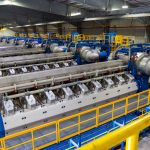Metro Milwaukee Has Edge with STEM Workers; Challenges with Startups, Growth
DataTool compares Milwaukee to peer metros on metrics of innovation, entrepreneurship
Metro Milwaukee maintains a competitive strength in the educational attainment of its workforce and its concentration of knowledge workers, especially scientists and engineers, which outpaces the nation and many peer metro areas.
But the region lags in other measures linked to innovation, such as startup investment, productivity, and employment and wage growth, according to findings of the Wisconsin’s Policy Forum’s newly updated Metro Milwaukee Innovation DataTool.
This year marks the third update of the DataTool, which debuted in 2019. The tool tracks the region’s performance over the last decade and in relation to national peers on 17 indicators tied to innovation, entrepreneurship, and economic growth. The peer metros are: Austin, Buffalo, Cincinnati, Cleveland, Indianapolis, Kansas City, Minneapolis-St. Paul, Oklahoma City, Pittsburgh, and Portland.
Many of these are midsized metros located in or near the Midwest, and share many of metro Milwaukee’s characteristics, including a historic focus on manufacturing. We also include two metro areas often identified as leaders in innovation (Austin and Portland) and national averages.
Areas of innovation strength for metro Milwaukee include:
STEM talent a highlight: One long-term strength of metro Milwaukee is its concentration of scientists and engineers, particularly industrial and mechanical engineers. In 2022, metro Milwaukee had a higher concentration of scientists and engineers than all but two of our comparison metros. Meanwhile, in 2022, metro Milwaukee outperformed six of our 10 comparison metros in its concentration of employment in 19 occupations defined as part of the tech workforce. Over 6,500 software engineers are employed in metro Milwaukee, making it the most common occupation among area tech workers.
Areas where improvement may be needed for metro Milwaukee to compete nationally include:
Venture capital funding a long-term challenge: One of metro Milwaukee’s longstanding weaknesses is venture capital investing, which typically supports startup companies with potential for growth. While venture capital investing is highly concentrated in a few coastal metros, metro Milwaukee trails even most Midwestern peers and has been near the bottom on this indicator for many years. On a per-capita basis, metro Milwaukee attracted considerably less in venture capital investment in 2022 than all but one of the peer metros. That was despite the region seeing its greatest investment total ($104 million) last year in data going back to 2014.
Employment, income growth lag: After growing jobs from 2010 to 2019, metro Milwaukee lost nearly all of those gains in 2020. The region has since recovered somewhat, but total employment in 2022 remained below 2015 levels. Job recovery has been much stronger nationally, with total employment in the U.S. reaching a new peak in 2022. Metro Milwaukee also is in the bottom tier among our comparison metros in employment growth since 2012 and added jobs at a far slower pace than the national average during that decade. And while the median income of metro Milwaukee households remains competitive with its peers, it grew at the slowest pace among our 11 comparison metros between 2012 and 2022 and was lower than the national average in 2022.
The Forum began tracking the four-county Milwaukee metro area’s performance on a set of economic indicators more than a decade ago, and we created this online DataTool in 2019. We hope these findings help economic development leaders and the broader community understand how the metro area is progressing and set priorities for future advancement.
Click here to access the 2023 Innovation DataTool.
The Wisconsin Policy Forum is the state’s leading source of nonpartisan, independent research on state and local public policy. As a nonprofit, our research is supported by members including hundreds of corporations, nonprofits, local governments, school districts, and individuals. Visit wispolicyforum.org to learn more.
NOTE: This press release was submitted to Urban Milwaukee and was not written by an Urban Milwaukee writer. While it is believed to be reliable, Urban Milwaukee does not guarantee its accuracy or completeness.
Mentioned in This Press Release
Recent Press Releases by Wisconsin Policy Forum
Act 12 Benefits Continue in 2025, But Fiscal Challenges Loom for Milwaukee County
Oct 16th, 2024 by Wisconsin Policy ForumAnnual budget brief finds the county’s brief era of largely pain-free budgets likely to be short-lived
Milwaukee Continues to Reap Act 12 Benefits, But Fiscal Challenges Remain
Oct 3rd, 2024 by Wisconsin Policy ForumProposed 2025 city budget includes bright spots, but future challenges point to need to find savings
Expanded Partnerships Could Help Address Milwaukee County Parks’ Unmet Needs
Feb 16th, 2024 by Wisconsin Policy ForumCollaboration among local governments could yield mutual benefits, report finds






















